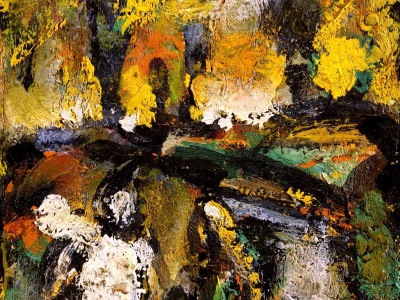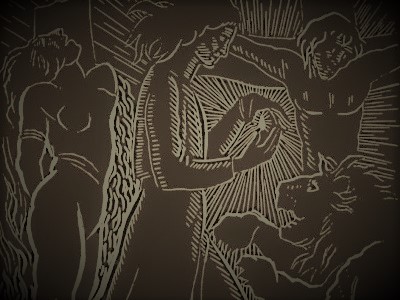Eberhard Arnold’s magnum opus, Inner Land, was the product of a lifetime of reflection on the spiritual life. For many, the book has been a source of spiritual enrichment and a challenge to follow Jesus Christ as one of his disciples. Yet Arnold does not write as systematically as contemporary writers in this genre, and sometimes the purpose of a particular line of argument is not completely clear. This series, then, aims to serve as a reader’s guide to the book, summarizing key points and themes, clarifying obscure passages, and offering commentary on historical, cultural, and theological connections.
The work that is now known as Inner Land first appeared as a series of ten articles in two different magazines in 1914.1 Initially intended for publication in a single volume under the name of The Inner Life, the project was nearing completion when Germany declared war on Russia and Arnold was sent to the front lines. After just three weeks, he was discharged because of ill health. No longer able to contribute to the war effort as a soldier, Arnold returned to his writing – but with a new slant. Weaving together his earlier thinking on the spiritual journey of the soul with ideas about the individual’s obligation to his homeland in times of trial, he reworked the original manuscript into The War: A Call to Inwardness.2
Arnold’s patriotism, though solid – even zealous – at first, began to wane as the war drew on. He noticed that the events had caused many to neglect their spiritual pursuits. Further, he could not reconcile the hatred that grew out of war with Jesus’s teachings. On a more personal level, he was shaken by the death of his brother, a solider, as was his wife, Emmy, who also lost a brother. He reworked the book once again, and in July 1918 he published it under the title Inner Land: A Guide to the Soul of the Bible.3 In contrast to the first edition, this one bore no trace of his earlier nationalist sympathies. There was another immediately visible difference: whereas the first edition had sported Germany’s imperial flag on the front cover, this new edition was decorated with a phoenix – an ancient symbol of new life rising from the ashes of the old.
Over the next decade, Arnold pursued work on other writing projects, and most of the rest of his time was given to leading the Bruderhof and traveling. In the early 1930s, however, he returned to Inner Land for yet another major rework. As his biographer notes, “At first glance not much is left of the 1918 edition – only the book’s skeleton, the general outline, and a few particularly striking pictures.”4 The first reworked chapter, “Light and Fire,” was published in booklet form in the politically charged year of 1933, offering subtly critical commentary on Nazi ideology. Arnold enclosed a copy in the personal letter he sent to Hitler that same year.5 His rejection of German nationalism toward the end of the First World War had reached its maturity in a comprehensive vision for Christian discipleship and the kingdom of God. Arnold completed a draft of the book’s last chapter in 1935, just weeks before his death. His son Eberhard C. H. Arnold (“Hardy”) took responsibility for the final editing, and the complete work was published in 1936. This edition forms the basis of the English translation, the focus of this series. Each volume corresponds to a different chapter in the German original.
Arnold introduces the 1936 edition of Inner Land with a brief chapter on the book’s themes and purpose. With a nod to the tumultuous interwar period and the rise of the Nazi Party, he begins, “The object of this book … is to make an appeal in all the political, social, and economic upheaval today. It is an appeal for decision in the area of faith and beliefs, directed to the hearts of all those who do not want to forget or lose God and his ultimate kingdom” (1).
Because the book’s title and language suggest an inward journey, it is important to address two possible misconceptions from the start. Arnold alludes to these in his opening paragraphs. First, the events of our time are not simply to be ignored so that the inner pursuit of God can continue unabated. Rather, “God’s approaching judgment is aimed at our hearts” (1); faithful response here means understanding these events not as extraneous to but as catalysts for the spiritual life. Second, the goal is not the quietist adoration of internal and immaterial things while neglecting bodily life and the sufferings of others. Arnold writes, “Through this Spirit, who moves and stimulates everything, we are meant to gain, from within, a life that outwardly demonstrates justice, peace, and joy in the Holy Spirit, as a form of life shaped by God’s active love” (1).
For people of faith, the Bible in itself will not suffice. “The heart of the Bible is more than the letter. … Only the Spirit who fills the heart of the Bible can lead us to its heart in spiritual freedom” (3). The purpose of scripture is divine encounter. In the same way, Inner Land seeks to go beyond mere intellectual stimulation or abstract discussion. Arnold intends for the work to aid the reader in the inner journey to repentance, new life, and dependence on God.
This relationship between inner and outer is further developed in Arnold’s reflections on secular society and the wealth generated through developments in capitalism following the Industrial Revolution: “With precipitous speed, we are being deprived of the inner blessing of our human calling by the outer blessing of our rapid development. Our public life has lost its human character, and inwardness has been damaged, as a result of the rush and hurry of all the work there is to do on the one hand, and on the other hand by the luxury, excess, and feverishly accelerated pleasure-snatching that has become part of life” (7–8). Modern European states enjoy economic prosperity, but at what cost? Society at large has allowed the inner to be determined by the outer, rather than vice versa: “Without an examination of our hearts in the light of God’s kingdom, we will continue to fall prey to new errors, expecting the nation to be lifted up by a human kingdom devoid of God’s Spirit” (8).
Jesus spoke at length about violent, large-scale social upheaval and the persecution of the church, which Arnold summarizes as “the horrors of universal war and bloody revolts, severe privations and plagues” (8).6 These have afflicted much of human history, and Arnold’s time and our own are no exception. He places special emphasis on Jesus’ prediction that, accompanying such events, “the love of many will grow cold” (Matt. 24:12). The First World War and the rise of Nazism had already shown this to be true. But Jesus also promises, “The one who endures to the end will be saved” (v.13). It is these words that Arnold wants his readers to keep in mind when reading his book. Evil things will indeed take place,7 but there is yet another way: the inward turn to true life in God that will bear outward fruit.
Continue:
Introduction
1.1. The Inner Life
1.2. The Heart
1.3. Soul and Spirit
2.1. The Conscience and Its Witness
2.2. The Conscience and Its Restoration
3.1. The Experience of God
3.2. The Peace of God
4.1. Light and Fire
4.2. The Holy Spirit
5.1. The Living Word
1. On this and the following, see Markus Baum, Against the Wind: Eberhard Arnold and the Bruderhof, trans. Eileen Robertshaw (Plough, 2015), 61-75. These articles have been digitized, translated, and made available on the website: “Sin and Pride,” “Inner Experiences,” “Peace and Moods,” “The Inner Life,” “The Conscience: Its Origin and Its Working,” “The Conscience: Its Healing in God,” “The Inner Light,” “The Word Alive within Us,” “The Temple of the Spirit and Our Inner Heart,” and “Soul and Spirit.”
2. The book has been digitized here. It has been transcribed in German, but the English translation is incomplete.
3. The book has been digitized here. It has been transcribed in German, but the English translation is incomplete. This edition was reprinted in 1923 without any revisions. It shares its title with the substantively revised 1936 edition, which forms the basis of the English translation. The latter translates Seele (soul) as “heart.”
4. Baum, Against the Wind, 172.
5. For more information, see the corresponding article in this series.
6. E.g., Matt. 24:6-13.
7. Arnold was speaking generally, but the work seems especially prescient in light of what was to follow in the coming years.


